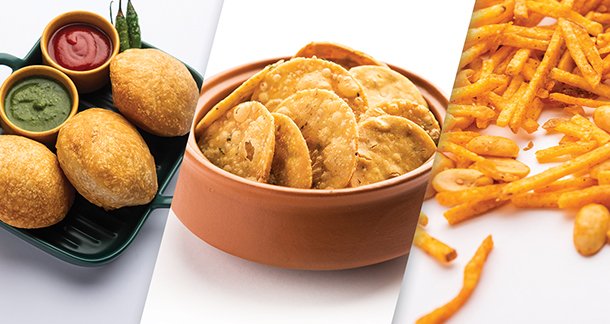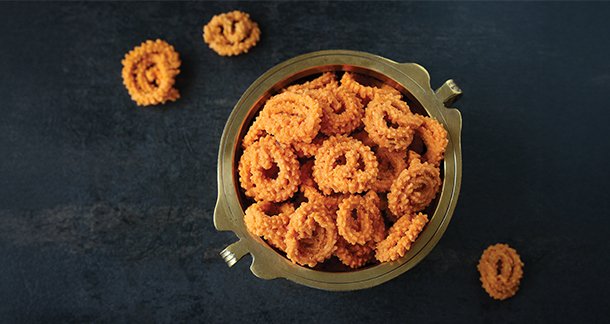The Indian snack market is one of the fastest-growing segments in the country’s food industry, driven by changing lifestyles, urbanization, and the evolving palate of consumers. Traditionally dominated by homemade snacks and street food, the industry has seen a significant transformation in recent years, with a shift toward packaged snacks, innovative flavors, and healthier options.
Key Categories in the Indian Snacking includes:
Traditional Snacks
Indian households have a long history of enjoying homemade snacks such as ‘murukku’, ‘kachori’, ‘mathri’, and ‘farsan’. In recent years, traditional namkeens like bhujia, sev, and mixture have transitioned into the organized sector, led by brands like Haldiram’s, Bikaji, and Balaji Wafers. These snacks remain popular for their familiar flavors and regional appeal. This trend is fast catching up in respective regional markets at this point of time.
Packaged Savory Snacks
Western snacks such as chips, crackers, and popcorn have become household staples, particularly among younger consumers. Brands like Lay’s, Pringles, and Bingo! have dominated this space with innovative flavors and targeted marketing campaigns. Newer flavors and baked formats are introduced to cater to the Gen-Zs and health-conscious segments respectively.
Sweet Snacks
Indian mithai (sweets) like ladoos, barfis, and soan papdi have also found a place in the packaged segment, with brands like Haldiram’s and Bikanervala offering longer shelf-life products. Western-style sweet snacks like cookies, chocolates, and pastries are growing rapidly, especially in urban areas.
Healthy and Functional Snacks
As health consciousness rises, snacks made with ingredients like millet, quinoa, roasted seeds, and baked alternatives have gained traction. Startups like The Whole Truth, Snackible, and Yoga Bar are addressing this demand with nutritious and guilt-free snacking options. It is interesting to observe more startups are entering the scene with prominent celebrities who have a wider reach and followers.
Street Food-Inspired Snacks
The diverse flavors of India’s street food culture have been recreated in packaged formats. Brands now offer pani-puri kits, chaat-flavored chips, and masala peanuts, blending the authenticity of street food with the convenience of packaged snacks. This trend is expected to continue with more innovation and experimentation.
Consumer Trends Driving Growth
Convenience and Accessibility
The demand for quick, ready-to-eat snacks has surged as busy lifestyles limit the time available for meal preparation. Packaged snacks are readily available across retail outlets and online platforms, making them accessible to a wider audience.
Taste Preferences
Indian consumers are adventurous with flavors, seeking innovative options that cater to their spicy, tangy, and savory tastes. This has led to the introduction of region-specific and fusion flavors.
Health and Wellness
Growing awareness of health issues has pushed consumers toward snacks with natural ingredients, low sugar, and minimal additives. Gluten-free, vegan, and protein-enriched options are in demand.
Premiumization
Urban consumers are increasingly willing to pay a premium for high-quality, artisanal, and gourmet snacks. Imported snack brands and luxury offerings are gaining traction in metropolitan cities.

E-commerce and Digital Influence
Online grocery platforms and direct-to-consumer websites have revolutionized the snack market. Consumers now have access to niche and international snack options with the click of a button.
Challenges in the Indian Snacking Market
Competition from the Unorganized Sector
Despite the growth of organized players, the unorganized sector continues to dominate, especially in rural areas, offering cost-effective options.
Health Concerns
The high salt, sugar, and fat content in many snacks has led to criticism, prompting companies to reformulate their products.
Regional Diversities
India’s diverse culinary preferences pose a challenge for brands aiming for national reach. Adapting flavors to suit regional tastes is crucial.
Supply Chain Complexity
Distributing products across India’s vast geography remains a logistical hurdle, particularly in remote areas.
Future Outlook
The Indian snacking market is on a promising trajectory, with innovation and consumer-centric strategies at its core. As consumers become more health-conscious and demanding, the industry will see a surge in healthier, premium, and experiential snack options. Digitalization will further enhance the reach and visibility of both established brands and niche players.
In the coming years, the balance between tradition and modernity will continue to define the Indian snacking landscape, making it an exciting and dynamic segment in the global food market.
About the author:
* Vignesh, CEO, F1rst, Industry Principal for Energy & Mobility division, works relentlessly towards creating value to the clients, understanding their needs and delivering insightful projects.



